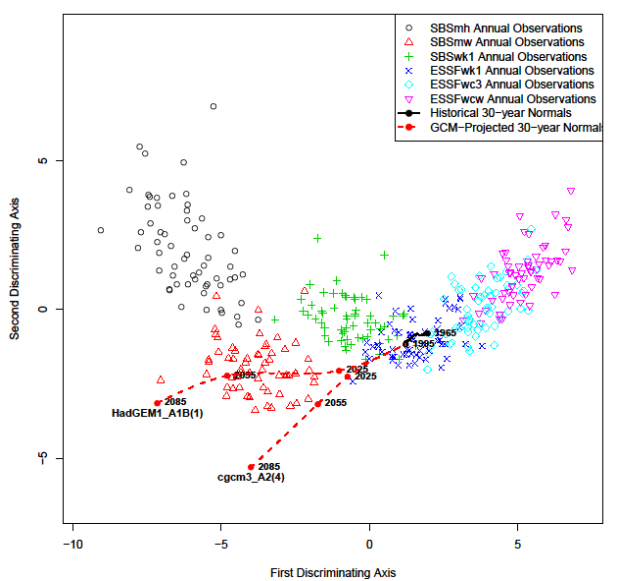Visualization of climate change is an important objective of my research. Without good visualizations, it is unlikely that my results will have much impact on even the most technical audience. However, portraying climatic variability and change in 2- or 3-dimensional space is extremely difficult without oversimplifying or abstracting the results. Trying visualize the “truth” of climate change in two or three dimensions may turn out to be in the same camp as searching for the holy grail, cold fusion, and perpetual motion… but I can’t resist giving it a decent try.
The previous blog found that discriminant analysis on the Quesnel-Barkerville BEC variants did not produce a meaningful visualization of climate space. The objective of the discriminant analysis in this case was to provide a reduced climate space in which trajectories, velocity, and novelty of climate change can be visualized relative to the differentiation between BEC variants. The first discriminant axis provided a meaningful index of dry/warm conditions. However, the second and third axes did not have an intuitive climatic interpretation. Importantly, the ability to detect novel conditions was likely severely constrained, because the dry/moist axis that inherently existed in the full-dimensional climate space was essentially removed from the reduced 5-dimensional discriminant climate space. These are fatal flaws for the use of discriminant analysis for the stated objective. It is very likely that other variance-based approaches (e.g. principle components analysis) would suffer from similar problems.
Despite these problems, I am not ready to abandon discriminant analysis entirely. It has the very desirable benefit of finding a low number of dimensions that efficiently define the differences between BEC variants. In the case of the Quesnel-Barkerville BEC variants, 79% of the total discrimination achieved by the analysis, following log transformations, occurred in the first dimension (if I am interpreting the meaning of “proportion of trace” correctly). It is possible that with further judicious transformations the discriminating power of the first dimension could be increased even further. In other words, discriminant analysis provided a single axis that described the essential differences between the six BEC variants. The problem with the analysis was in the second and third axes. The first axis is the baby; the second and third axes appear to be the bathwater.
One possible solution would be to find a second and third axis that describe climatically meaningful orthogonals to the first discriminating axis. The first axis in the Quesnel-Barkerville analysis appears to be an index of dry/warm. The second axis could be an orthogonal wet/warm index. This could be done in three dimensions too if a third component was apparent in the axis1 index (e.g. snow depth, continentality). I’m not sure what the criteria would be to choose the orthogonals, but the idea is worth some further thought.
That’s one idea, but I obviously need to do a review of my options. The following is a brainstorm of potential approaches that need some research and/or consideration:
- Modifications of LDA, as described above.
- Multidimensional Scaling (MDS). This is a broad class of techniques for dimension reduction. The common goal of MDS techniques is to preserve between-object distances as well as possible in a predetermined subset of dimensions.
- Supervised variable selection. This approach would use raw (unrotated) variables as axes for a 2- or 3-dimensional simplified climate space. In other words, this is feature selection rather than the feature extraction performed by axis rotation (e.g. LDA, PCA). The key would be to choose a single focal BEC variant and select 2 or 3 variables that most powerfully differentiate the focal BEC variant from its neighbours in high-dimensional climate space. This focal-variant approach is viable because climate change trajectories are visualized for individual geographical locations. the analysis could be iterated through raster cells for regional/provincial scale summaries and maps.
- Localized linear discriminant analysis (Czogiel et al. 2007). This approach is similar to raw variable selection for focal variants, but it does a localized feature extraction (LDA) instead. Rather than treating all groups as equal for calculation of the discriminating functions, this approach weights the calculation based on proximity of each group to a single multivariate coordinate (e.g. the climatic centroid of a BEC variant). This approach seems to be pretty obscure, but it is worth investigating.
- Exotic visualization techniques, e.g. Information Flocking Boids. There are a lot of attractive but mathematically opaque approaches out there. While these are worth a cursory review, I have a feeling I could go down the rabbit hole with this stuff.
- No dimension reduction: just use measures such as Standardized Euclidian distance (Williams et al. 2007) or clustering to describe shifts into analogous or non-analogous climate space. Results can be visualized by mapping them geographically (e.g. colour coding raster cells by degrees of climatic novelty). While a full-dimensional analysis is likely an important component of my research, I am reluctant to give up on portraying visualizations of climate change in reduced climate space.
I will evaluate each of these approaches in future blog posts.
References
Czogiel, I., K. Luebke, M. Zentgraf, and C. Weihs. 2007. Localized linear discriminant analysis. Pages 133–140 in R. Decker and H. Lenz, editors. 30th Annual Conference of the German-Classification-Society.
Williams, J. W., S. T. Jackson, and J. E. Kutzbach. 2007. Projected distributions of novel and disappearing climates by 2100 AD. Proceedings of the National Academy of Sciences of the United States of America 104:5738–42.
